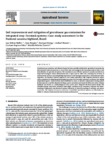Please use this identifier to cite or link to this item:
http://www.alice.cnptia.embrapa.br/alice/handle/doc/1003272Full metadata record
| DC Field | Value | Language |
|---|---|---|
| dc.contributor.author | BULLER, L. S. | pt_BR |
| dc.contributor.author | LIMA, I. B. T. de | pt_BR |
| dc.contributor.author | ORTEGA, E. | pt_BR |
| dc.contributor.author | MORAES, A. | pt_BR |
| dc.contributor.author | SILVA, G. B. S. da | pt_BR |
| dc.contributor.author | ZANETTI, M. R. | pt_BR |
| dc.date.accessioned | 2015-06-13T05:31:44Z | - |
| dc.date.available | 2015-06-13T05:31:44Z | - |
| dc.date.created | 2014-12-19 | pt_BR |
| dc.date.issued | 2014 | pt_BR |
| dc.identifier.citation | Agricultural Systems, v. 137, p. 206-219, 2015. | pt_BR |
| dc.identifier.uri | http://www.alice.cnptia.embrapa.br/alice/handle/doc/1003272 | pt_BR |
| dc.description | Greenhouse gas emissions and climate change has been partially attributed to agricultural expansion by deforestation, while the pressure to assure food, fiber and energy for the future generations leads to the intensification of agricultural systems. The transition to more efficient systems is actually considered an important strategy to reduce deforestation and to spare land for other uses, including the recovery of environmental services and ecohydrological processes in the drainage basin such as carbon sink and water regulation. The Brazilian Federal Program for Low Carbon Agriculture (ABC Program) intends to reduce carbon emissions by stimulating technological processes that neutralize emissions or enhance the sinking of greenhouse gases. A pilot farm has been established to assess an intensive animal-plant farming system that incorporates anaerobic digestion for biogas, power generation and organic fertilizer production. Emergy Synthesis was chosen as a methodological tool to assess and to diagnosis the farm system design. The modified emergy assessment including externalities (greenhouse gas emissions) improves the understanding of integrated crop?livestock systems efficiency in internal recycling of nutrients and power conversion. The adoption of manure treatment in intensified agricultural systems can effectively contribute to enhance environmental and economic performances. | pt_BR |
| dc.language.iso | eng | eng |
| dc.rights | openAccess | eng |
| dc.subject | Ecohydrology | pt_BR |
| dc.subject | Emergy synthesis | pt_BR |
| dc.subject | GHG mitigation | pt_BR |
| dc.subject | Nutrient cycling | pt_BR |
| dc.subject | Renewable energy | pt_BR |
| dc.title | Soil improvement and mitigation of greenhouse gas emissions for integrated crop-livestock systems: Case study assessment in the Pantanal savanna highland, Brazil. | pt_BR |
| dc.type | Artigo de periódico | pt_BR |
| dc.date.updated | 2015-06-13T05:31:44Z | pt_BR |
| riaa.ainfo.id | 1003272 | pt_BR |
| riaa.ainfo.lastupdate | 2015-06-11 | pt_BR |
| dc.identifier.doi | http://dx.doi.org/10.1016/j.agsy.2014.11.004 | pt_BR |
| dc.contributor.institution | LUZ SELENE BULLER, UNICAMP; IVAN BERGIER TAVARES DE LIMA, CPAP; ENRIQUE ORTEGA, UNICAMP; ANIBAL MORAES, UNIVERSIDADE FEDERAL DO PARANÁ; GUSTAVO BAYMA SIQUEIRA DA SILVA, CNPM; MARILIA RIBEIRO ZANETTI, BOLSISTA CPAP. | pt_BR |
| Appears in Collections: | Artigo em periódico indexado (CNPM)  | |










